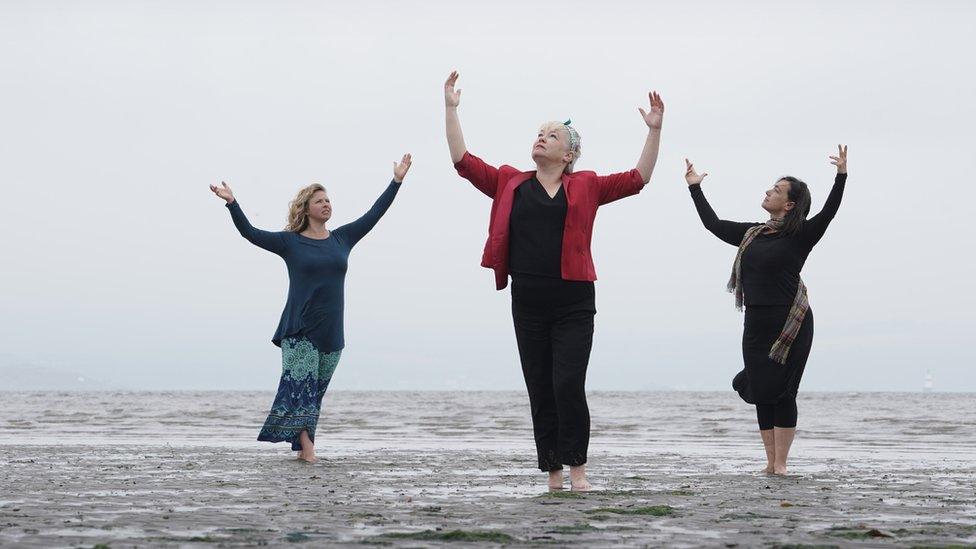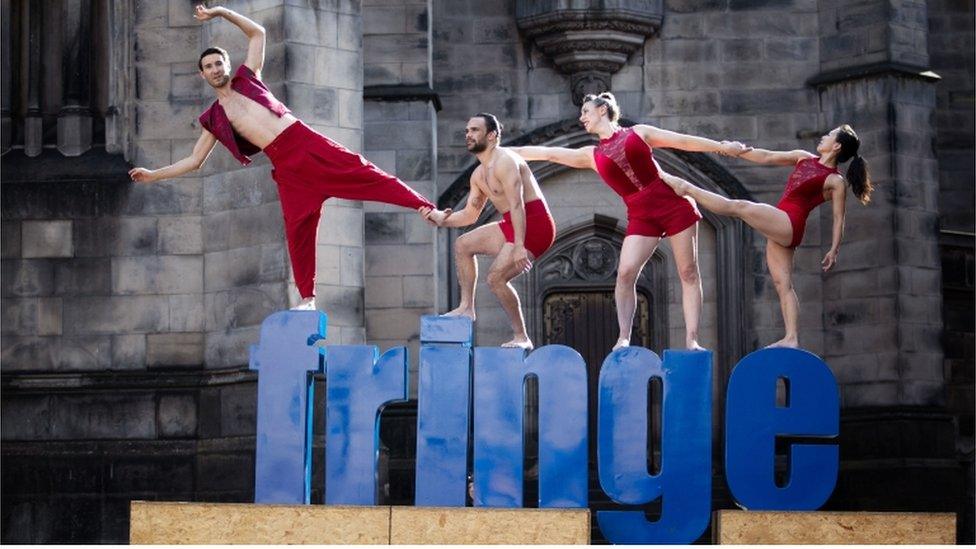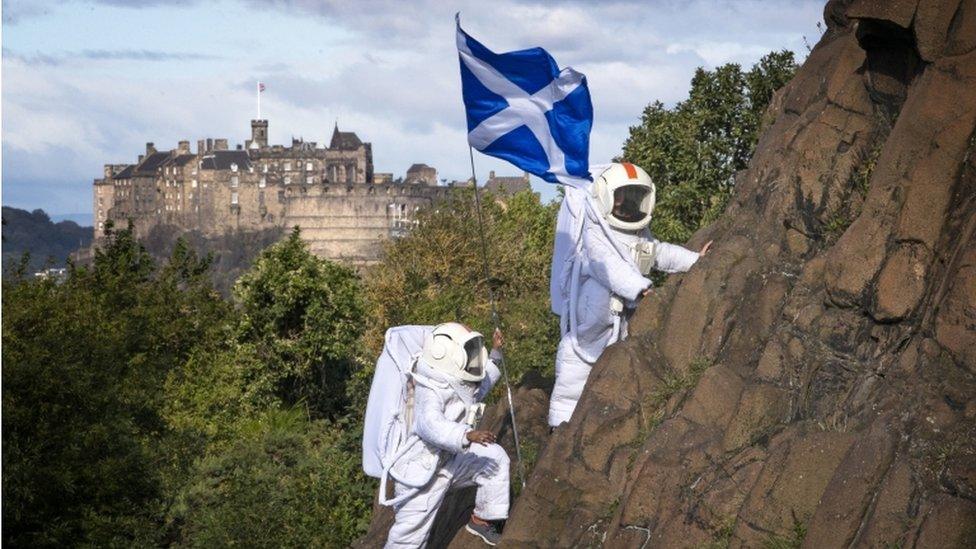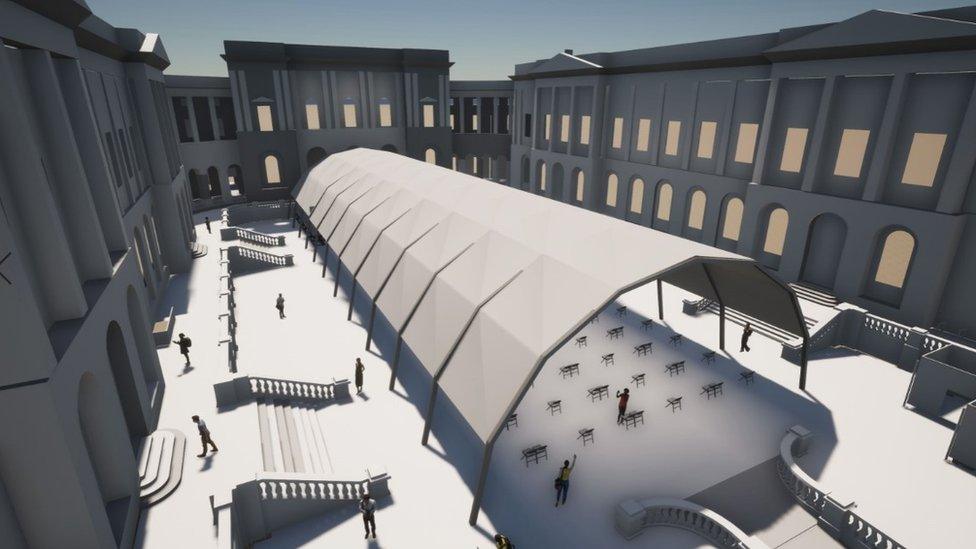A very different Edinburgh Fringe but the same spirit
- Published

Outdoor productions will be a major part of the Fringe this year
The Edinburgh Fringe will look different this year but "embracing the unknown and turning it into something magical is what the Fringe does best".
Shona McCarthy, the chief executive of the Edinburgh Festival Fringe Society, has announced tickets for 170 shows for the world-famous festival, which runs from 6 to 30 August., external
Although more will be announced in the coming weeks, it will be nowhere near the 3,800 shows in the years before the pandemic.
I wasn't around for the first Edinburgh Fringe in 1947 but I'm guessing there wasn't much pre-publicity.

The Fringe usually has performers from all over the world
The Second World War had just ended, rationing was still in force and thousands of displaced civilians and servicemen and women were still finding their way back home.
And yet, this was the moment when Edinburgh decided what the world needed most was a cultural celebration.
Local people rose to the challenge. Legend goes they gave their coal rations to light the castle at night. No first class travel, or fancy hotels. Performers were given board and lodgings with the first patrons of the Edinburgh International Festival.
And right from the start, what most referred to as the Edinburgh Festival was in fact several festivals, with film, art and military tattoo all running alongside the international festival.
And, of course, the Fringe.

The streets of Edinburgh are usually packed during August's festival season
The festival which began when those not invited to any of the formal events, decided to simply roll up and stage their own shows wherever they could find a space.
Eight companies came that first year including Glasgow Unity Theatre. No lengthy runs, or expensive accommodation. They simply played their shows in six makeshift venues and went home afterwards.
Shows alternated between sell-out and empty, a tradition which has continued on the fringe ever since.
Those original six venues quickly multiplied.

In the past, performances have taken in places in venues such as Arthur's seat and Salisbury Crags
Church halls and community centres, gym halls and gardens were all pressed into action.
There are few spaces in Edinburgh which haven't provided a stage for a Fringe show. I've been to shows on buses, in a taxi, a swimming pool, the top of Arthur's Seat, and an island in the Firth of Forth.
And even in the midst of this crazy maze of 50,000 performances, with multiple festivals running simultaneously and things happening at any time of day or night, it was still possible to find the spirit of '47.
Where everyone is equal, whether you're a high school student or a Hollywood superstar. Where unknowns like Phoebe Waller Bridge are spotted by TV executives, and well-knowns like John Malkovitch take their turn handing out flyers on the Royal Mile.
This year, more than ever, that spirit is needed.

The Fringe brochure usually contains thousands of shows
By now, the Fringe brochure should have been published. A telephone directory-sized collection of listings.
Venues would be booked, staff would be contracted.
Although the latest government guidance is that social distancing should be unnecessary by 9 August, most venues are understandably nervous. Any slippage of dates could be costly and it's impossible to plan ahead.
As one venue producer explained, it's a tricky balancing act being both slow and cautious in reopening venues and instilling confidence in audiences to return.
Everyone has to be ready for anything. Losing precious rehearsal time if anyone has to isolate, refunding tickets without question if it happens to an audience member.
The only sustainable offer is a blended programme with outdoor performances as well as indoor ones, and digital shows.
This year sees the launch of the Fringe Player which will provide a platform for scheduled shows and on demand, which can be watched at the viewer's leisure.
The Scottish government has committed more than £1.3m to the Edinburgh International Festival and nine Fringe producers to allow them to create outdoor performance spaces, among them Summerhall, Pleasance, The Space UK, Assembly, Underbelly, Gilded Balloon, Zoo, Dancebase and the Traverse.
On Thursday, the Fringe Society has put tickets for 170 shows on sale. Given the challenges, it's quite a feat, and no-one knows quite what to expect, but it's bringing out the best of the Fringe.
It's going to feel like a very different festival, this year.
No packed streets and late night revellers, no star spotting in local cafes and bars, no checking your watch as the nightly fireworks explode above the military tattoo on the castle esplanade.
But it beats the eerie quiet of empty courtyards of last year and gives a moment of hope for an industry laid low by Covid.
And as they look to 2022, and the 75th anniversary of these extraordinary festivals, it seems like the right moment to step back, take stock, and then put the show on, wherever you can.
- Published13 April 2021
